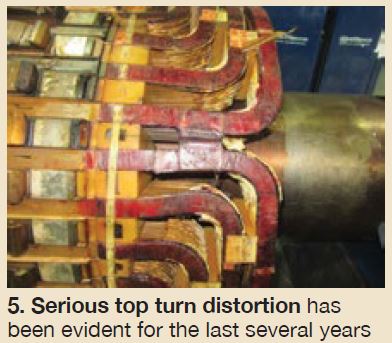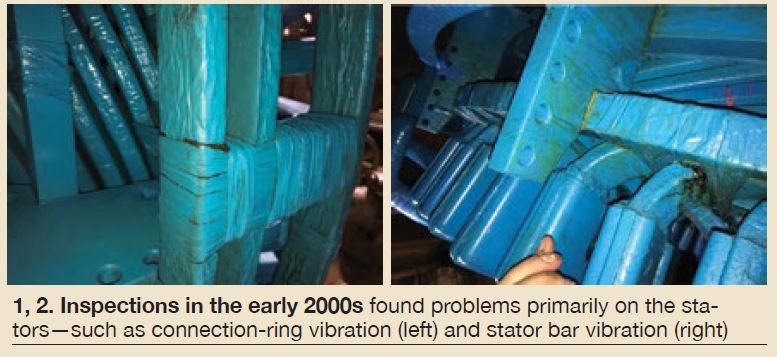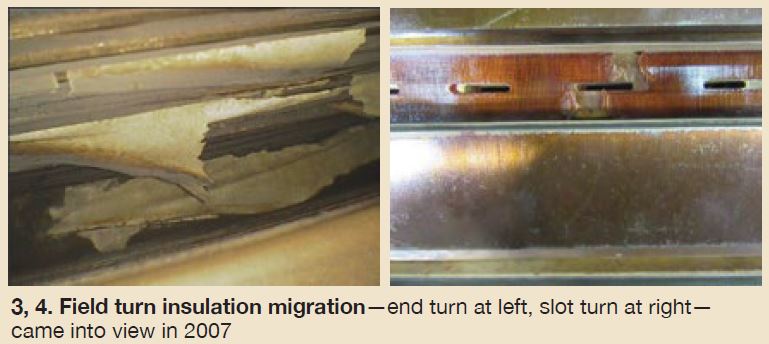Editor’s note: This article is based on the presentation, “Frame 6/6A3 ‘minor’ outages turned into majors with field rewinds,” by Jamie Clark of AGT Services Inc at the 2019 meeting of the Frame 6 Users Group.
As production of renewable energy has grown so has cyclic duty on traditional turbine/generators increased. The adverse impacts of increased cycling are well illustrated by experience at a 1990s-vintage, Frame-6B-powered, 3 × 1 combined-cycle plant where each gas turbine drives a nominal 45-MVA, air-cooled 6A3 generator. The gas turbine/generators are arranged to also operate in simple-cycle mode.
A dozen inspections were conducted on GT generators at this plant from 2001 through 2019, allowing a meaningful assessment of deterioration rate. Engineers found that generators deteriorated at a greatly increased rate when cyclic duty changed from perhaps a half dozen cycles per month to a half dozen cycles per week (especially during the summertime) beginning about 2005-06. The damage primarily has appeared on the rotating fields, as experts expected.
Inspections conducted in 2001, 2002, and 2003 found problems primarily on the stators (Figs 1 and 2). Loose wedges also were observed. Stator rewedging was performed to replace the “camel-back” wedge systems, a system of rather poor design used for a few years by this OEM.
By 2007, field turn insulation migration was beginning to be noticed. By 2015, insulation migration was sufficient to schedule the first of the field rewinds; however, that work has yet to begin (Figs 3 and 4).
Load cycling causes the copper turns to have a tendency to move axially at the field body ends, and to assure the turn insulation lamination stays in place each lamination is bonded on one side to the adjacent copper turn.
The heavy cyclic duty combined with elevated temperatures over time may cause debonding and allow the turn insulation to migrate out of place. If the migration becomes severe, turn shorts begin to occur; the only repair is field rewind. This was the case on two of the generators at this site. Minor inspections resulted in finding gross turn insulation migration, forcing unplanned major outages for field rewinds.
In recent years, serious top turn distortion became apparent (Fig 5). This copper distortion is caused by a combination of insufficient copper hardness, endwinding blocking design, and cyclic duty—and is a fairly common problem on fields. By 2018, distortion had reached a level sufficient to require field rewind, and the first of the fields was rewound. The second field was rewound in 2019 because of nearly identical copper distortion.
Cycling of conventional powerplants will only increase as time passes. It is important that plant owners recognize this and plan maintenance accordingly. Inspection frequency will need to increase and qualified expert help should be available to assist in the decision process. When a rewind is to be performed, available cyclic-duty modifications should be incorporated in the new windings.
For stators this would include (1) an endwinding support structure that adequately allows for the always-present axial expansion of stator bars, (2) bonding or clamping of endwindings and connection rings to allow axial expansion while preventing vibration at contact points, and (3) proper stator wedge material selection and design to remain mechanically stable throughout the normal operating and cycling temperature ranges.
Field rewinds must incorporate proper copper hardness, especially in the slot portion of the coil. The slot armor insulation system must have a robust slip plane to accommodate winding expansion and contraction, as well as stress relief of the slot armor at the field body slot exits.
The best available turn insulation materials are required, with proper thickness and high-quality adhesion to an adjacent turn. Blocking under the retaining rings must allow for the small but important copper expansions that always occur, and have proper restraints implemented to eliminate blocking migration and assure blocking that will stay in place. Finally, the retaining- ring insulation material must ensure thickness stability and have a robust slip plane to allow for copper end turn expansion and contraction.
As asset owners are increasingly challenged to run these older units a “bit harder” than historically, and are pressured to reduce maintenance costs, a decision must be faced—that is, weighing the immediate benefits of minor inspections only or facing the cost of major inspections. The decision should consider the unit’s history, fleet experience of similar units and planned changes in duty. Cost savings from “minor inspections only” may likely be lost many times over if they turn into costly unplanned major outages.
Acknowledgement: Clyde V Maughan contributed to this article.





